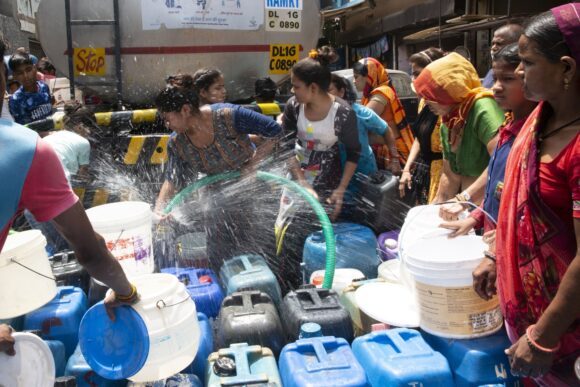Climate change-driven heat waves are impacting everything from nuclear reactors in France to glaciers in Pakistan. As millions of people around the world are forced to cope with more stifling temperatures, some are turning to hacks like air-conditioned clothing. Cities are doing everything from planting trees to deploying 1,000-year-old underground canal technologies in a bid to keep cool.
Despite these efforts to adapt, heat waves are putting costly burdens on businesses and individuals. To meet this problem, some financial service providers have started to offer instruments aimed at reducing personal and economic risk associated with heat waves. From heatstroke insurance to plans that reimburse dairy farmers when cows are too hot to produce milk, this new wave of products may help communities build financial resilience to the impact from warmer temperatures.
Here are five ways the financial industry is trying to de-risk the impact of more extreme heat waves.
Heatstroke Insurance
Japan’s Sumitomo Life Insurance Co., in collaboration with SoftBank Group Corp.’s mobile-payments unit PayPay, began offering heatstroke insurance last year and sold more than 60,000 policies.
The coverage costs as little as 100 yen (75 cents) daily, and if purchased before 9 a.m., the policy can take effect from 10 a.m. that day, covering hospitalization and other medical costs caused by the heat and sun.
This year the group is aiming to expand sales and spokesman Junichiro Kaneda said the company believes global warming will accelerate the number of heat stroke cases. Rival Sompo Japan Insurance Inc. began offering a similar policy last year that can be added to personal injury insurance and views the coverage as a necessary protection for existing customers.
“The need for heat stroke protection is likely to increase if the hot summer days increase due to global warming,” said Ayumi Oohata, a deputy manager with Sompo.
Tokyo recorded the warmest average temperature for the month of March since 1876, according to data from the Japan Meteorological Agency, while last June the metropolitan prefecture experienced the most extreme heat wave for that month in records going back to 1875, according to the Japan Weather Association.
Recovering Lost Wages
This year India recorded its hottest February since 1901, and now forecasters are predicting a repeat of the intense heat wave last year that damaged crops and strained its power network. The country’s vast informal labor market, many of whom are women, are often exposed to dangerously hot conditions for extended periods of time.
A new service aims to replace daily incomes, estimated at around $3 a day, if specific weather conditions are met that are expected to result in negative health outcomes, according to Adrienne Arsht-Rockefeller Foundation Resilience Center and the Self Employed Women’s Association (SEWA), which are providing the service.
India is one of the most vulnerable countries to climate change. More extreme weather events such as heat waves, heavy flooding and severe drought kill thousands every year and increase economic hardships by eroding farm productivity. The number of Indian states hit by heat waves since 2015 more than doubled to 23 by 2020.
Last year, India suffered its hottest March in more than a century, scorching the grain harvest and forcing the government to curb exports.
Milk Protection
Humans aren’t the only ones impacted by sweltering temperatures: the extreme weather can trigger heat stress in cows, resulting in lower milk production.
ITK, an agricultural research company, and reinsurer SCOR announced in 2021 that they were launching a heat stress product for dairy farmers to help protect them against economic losses from stressed livestock due to hotter temperatures. The service monitors weather conditions and notifies policy holders if they’re eligible for compensation.
The insurance also helps dairy producers predict heat stress and adapt management systems to boost resilience among livestock. While the product is initially targeted at cows, ITK says it could also be adapted to cover losses associated with other farm animals. Last year about 75,000 dairy cows in France were covered and the policy paid out roughly 200,000 euros to farmers.
Crop Insurance
Agriculture has always been at risk from drought and pests, but climate change is exacerbating those concerns.
Australian-based startup Hillridge Technology Pty has developed a platform aimed at helping farmers assess their weather risk. The service also allows farmers to purchase policies through brokers and insurers to protect against threats not covered by traditional agricultural policies, said Dale Schilling, the company’s co-founder.
“Traditional crop insurance covers bush fires and it covers hail but it doesn’t cover the risk of heat stress killing your crops or drought or too much rain at the wrong times or a frost event, which could cripple a farmer’s yield,” he said. Premiums tend to higher than traditional insurance because more risk is covered.
If specific weather triggers occur, and policy holders confirm they suffered, a loss a payout is made. These triggers could range from extreme heat, or cold, flooding or drought. Hillridge launched in Australia in 2021 and plans to operate in Vietnam and Indonesia, Schilling said earlier this year.
Weather Futures
Temperature-based index futures and options have offered a way for companies such as utilities to hedge against weather risks for more than two decades. In recent years, heightened awareness of climate-related risks has contributed to increased demand, according to CME Group, a provider of these contracts.
The group’s products quantify how much temperature deviates from the monthly or seasonal average in a particular city. As of the first week of March, the average daily volume of the CME Group’s weather contracts year to date was up 560% compared with the same period in 2022.
That growth is coming from a wide range of customers including insurance companies, mutual funds and hedge funds as well as energy, power and utilities companies, according to the company.
–With assistance from Sybilla Gross and Shoko Oda.
Photograph: Residents fill water from a water tanker in Kusumpur Pahari slum in New Delhi, India, on Friday, May 13, 2022. Photo credit: Ruhani Kaur/Bloomberg
Was this article valuable?
Here are more articles you may enjoy.



 DoorDash, Uber Cost Drivers $550 Million in Tips, NYC Says
DoorDash, Uber Cost Drivers $550 Million in Tips, NYC Says  Oklahoma Senate Minority Leader Proposes Insurance Reform Bills
Oklahoma Senate Minority Leader Proposes Insurance Reform Bills  Thumbs Down on SELF DRIVE Act as Written, Says Industry Trades
Thumbs Down on SELF DRIVE Act as Written, Says Industry Trades  10,000 Travelers Employees Get AI Assistants Via Anthropic Partnership
10,000 Travelers Employees Get AI Assistants Via Anthropic Partnership 

